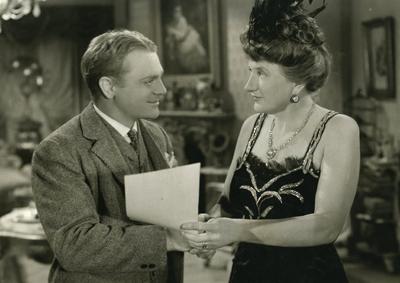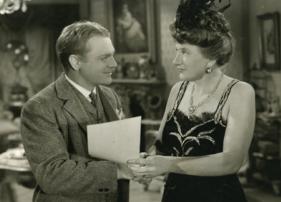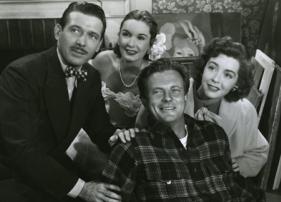Directed by William K. Howard
Buoyed by the critical and commercial success of Yankee Doodle Dandy (1942), and following a series of well-publicized contract disputes with Warner Brothers, in 1942 James Cagney struck out with younger brother William to form the independent production company Cagney Productions. Johnny Come Lately would be the first of three films produced by the venture, an attempt to allow Cagney to expand his acting repertoire beyond the wisecracking, pugnacious gangster roles that had made him famous.
Set in small-town America in 1906, the film finds Cagney playing Tom Richards, a kind-hearted drifter and sometime newspaperman who helps elderly widow Vinnie McLeod (Grace George) save her newspaper and overcome leading citizen Bill Dougherty’s corrupt hold on the town. Loitering in the town square of seemingly-idyllic Plattsville, Tom is warned by Vinnie of the town’s harsh treatment of vagrants, but is heedless and winds up in court, where it becomes apparent that the judge and most of Plattsville is under the thumb of the deep-pocketed Dougherty.
Taking an interest in Tom’s plight, Vinnie saves him from being sentenced to a work gang by hiring him for her newspaper, which is under heavy pressure from Dougherty and his rival paper. Tom in turn becomes the widow’s protector and champion of her cause, as her paper fights to expose Dougherty’s machinations. Here, Cagney’s wit and sureness are employed in the service of good: with a bit of guile, a lot of muckraking journalism, and a clever deployment of ketchup, Richards manages to maneuver the townsfolk (including Marjorie Main as loud-mouthed roadhouse proprietress Gashouse Mary) to Vinnie’s side. In this endeavor, though, Cagney is not too far removed from his bruising wise guy ways for the thrills of a shootout, high-speed carriage chase, and some vigorous fisticuffs.
Though Cagney Productions would ultimately be reconfigured as part of Warner Brothers, Johnny Come Lately and subsequent productions provided a trailblazing model in more ways than one; as a Saturday Evening Post article of the time observed: “They go about the business of making independent productions with pleasant informality, and there is a minimum of screaming and hair-tearing on the Cagney sets.”
Nina Rao
Cagney Productions, Inc./United Artists Corp. Producer: William Cagney. Screenwriter: John Van Druten. Cinematographer: Theodor Sparkuhl. Editor: George Arthur. With: James Cagney, Grace George, Marjorie Main, Marjorie Lord, Hattie McDaniel.
35mm, b/w, 97 min.
Preserved by The Academy Film Archive and UCLA Film & Television Archive in cooperation with Paramount Pictures from a 35mm nitrate composite fine grain master positive. Laboratory services by The Stanford Theatre Film Laboratory, Audio Mechanics, DJ Audio, Simon Daniel Sound.






 Mobile Navigation
Mobile Navigation



